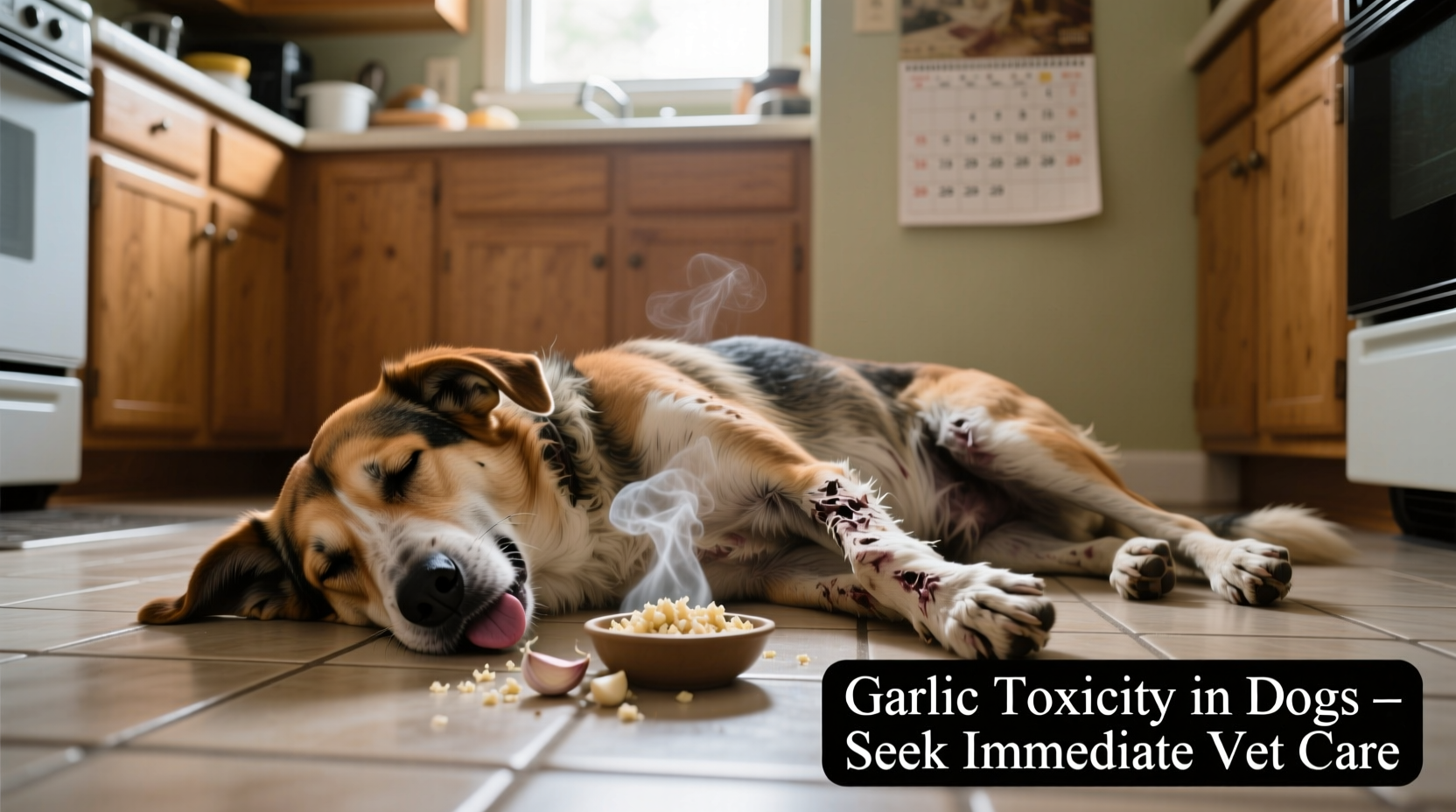As a dog owner, discovering your pet has eaten garlic can trigger immediate panic. Understanding the real risks and knowing exactly what to do could save your dog's life. This guide provides vet-verified information about garlic toxicity in dogs, including dangerous thresholds, symptom timelines, and critical action steps.
Why Garlic Is Dangerous for Dogs: The Science Explained
Garlic belongs to the Allium family (along with onions, leeks, and chives), containing organosulfur compounds that oxidize hemoglobin in red blood cells. According to the ASPCA Animal Poison Control Center, this triggers Heinz body formation, leading to hemolytic anemia where the body destroys its own red blood cells faster than they can be replaced.
Unlike humans, dogs lack sufficient enzymes to metabolize these compounds safely. The Merck Veterinary Manual confirms that repeated exposure to even small amounts causes cumulative damage, making seemingly minor incidents potentially dangerous over time.
How Much Garlic Is Toxic to Dogs?
The toxic threshold varies significantly based on your dog's size, breed, and overall health. Japanese breeds like Shiba Inus and Akitas show heightened sensitivity due to genetic factors affecting red blood cell metabolism.
| Dog Weight | Garlic Amount | Risk Level | Expected Symptoms |
|---|---|---|---|
| 10 lbs (4.5 kg) | 5 grams (1 clove) | Moderate | Vomiting, lethargy |
| 50 lbs (23 kg) | 15 grams (3 cloves) | High | Weakness, pale gums |
| Any size | Repeated small doses | Severe | Hemolytic anemia |
Symptom Timeline: What to Watch For
Garlic poisoning symptoms typically develop gradually. Recognizing these stages helps determine urgency:
- 0-24 hours: Vomiting, diarrhea, abdominal pain (often mistaken for simple stomach upset)
- 24-72 hours: Lethargy, weakness, rapid breathing (signs of developing anemia)
- 3-5 days: Pale gums, dark urine, jaundice (critical indicators of severe hemolysis)
- 5+ days: Organ damage or death if untreated (due to oxygen deprivation)
A 2022 study published in Veterinary Sciences documented cases where dogs developed life-threatening anemia after consuming garlic powder at concentrations as low as 1.5g/kg body weight—equivalent to just two cloves for a medium-sized dog.

Immediate Action Plan: What to Do If Your Dog Ate Garlic
Time is critical when addressing potential garlic toxicity. Follow these vet-recommended steps:
- Calculate exposure: Weigh any remaining garlic or packaging to determine approximate consumption
- Contact emergency help: Call ASPCA Animal Poison Control (888-426-4435) or your vet immediately—do not wait for symptoms
- Induce vomiting only if instructed: Never use hydrogen peroxide without professional guidance
- Document symptoms: Note exact timing of observed changes for veterinary assessment
- Prepare for treatment: Expect possible hospitalization for blood tests, IV fluids, and oxygen therapy
Veterinary treatment typically involves activated charcoal administration within 2 hours of ingestion, followed by supportive care. In severe cases, blood transfusions become necessary when red blood cell counts drop below 20%.
Common Misconceptions About Garlic and Dogs
Several dangerous myths persist in pet care communities:
- "Natural flea prevention": No scientific evidence supports garlic for flea control—studies show it provides zero protection while risking toxicity
- "Cooked garlic is safe": Cooking doesn't eliminate thiosulfates; concentrated forms like powders pose even higher risks
- "Small amounts are harmless": Cumulative exposure from repeated small doses causes delayed but severe toxicity
Preventing Garlic Exposure: Practical Safety Measures
Protect your dog with these proactive strategies:
- Store all garlic products in locked cabinets—dogs can open containers
- Check pet food ingredients for garlic derivatives (common in "natural" formulas)
- Supervise during meal preparation—garlic scraps tempt curious dogs
- Educate family members about hidden garlic sources (baby food, broths, seasonings)
When Garlic Might Be Less Dangerous: Context Matters
Certain factors can modify risk levels, though never eliminate them completely:
- Dog size: Larger breeds tolerate slightly higher thresholds (but no safe minimum exists)
- Health status: Dogs with pre-existing anemia face amplified risks
- Garlic form: Powdered garlic concentrates toxins (1 teaspoon powder = 5 cloves fresh)
- Exposure frequency: Single incidents pose lower risk than repeated exposure
Remember: No veterinary association recognizes any safe level of garlic consumption for dogs. The American Kennel Club explicitly states that "all forms of garlic are toxic to dogs" regardless of preparation method.
Frequently Asked Questions
How soon after eating garlic do dogs show symptoms?
Initial symptoms like vomiting typically appear within 24 hours, but dangerous anemia develops gradually over 3-5 days. Monitor your dog for 72 hours after exposure, watching for lethargy, pale gums, and dark urine.
Can a small amount of garlic kill a dog?
Yes, even small amounts can be fatal to small breeds or sensitive dogs. A single clove could kill a 10-pound dog, while larger dogs face risks from repeated exposure. There is no safe minimum dose established by veterinary toxicologists.
What should I do if my dog ate garlic bread?
Contact your vet immediately. Garlic bread combines multiple risks—garlic toxicity plus potential pancreatitis from fats. Provide details about portion size and ingredients. Do not induce vomiting without professional guidance.
Are some dog breeds more sensitive to garlic?
Yes, Japanese breeds (Shiba Inus, Akitas) show heightened sensitivity due to genetic differences in red blood cell metabolism. Puppies and dogs with pre-existing anemia also face amplified risks from garlic exposure.











 浙公网安备
33010002000092号
浙公网安备
33010002000092号 浙B2-20120091-4
浙B2-20120091-4